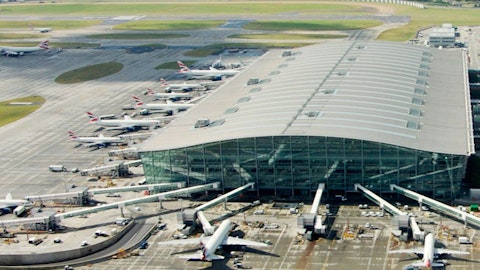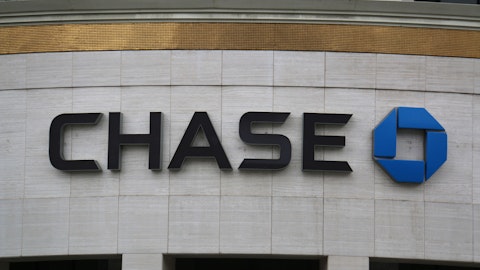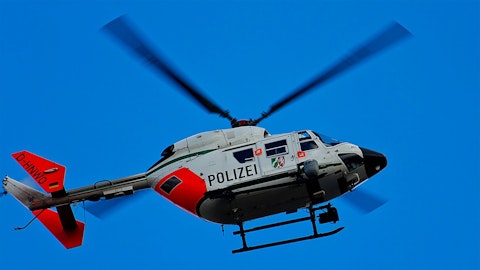Will Heyburn: Well, I’ll start just on the profitability front. The whole airport business was flight profit positive in the quarter. So that’s not just covering the flight cost, that’s covering the cars on the ground and everything. And though the longest standing route from the west side of Manhattan to JFK is the most profitable, we’re now seeing profitability from all the routes. The ones that haven’t had as much time, they’re not contributing as much. But we’re really excited at the progress that we’ve made. And it’s been a long time coming, and we’ve had to be really patient. And as we talked about in prior calls, we’re coming at it from both angles. We got more passengers flowing through the system.
But in addition, we’re seeing passengers elect to pick more flexible fare options. They’re going for upgrades. It’s raising that average price per seat, which makes it easier to get to that profitability level, too. So we’re really pleased that it’s across the routes and, as we talked about in the script, still seeing really strong growth in the number of seats flown quarter-to-date. So the best is yet to come. And I’ll let Rob talk a little bit about route expansion.
Rob Wiesenthal: Yes. So look, I take a look at it, and there’s no question that our JFK route is the flagship route for Blade. It’s consistently profitable, it’s high margin, and it also offers the biggest time savings, especially from the west side to JFK. We’re literally saving up to two hours for people who would normally drive from the west side. Newark, I think is doing fine. It has profitability. East side to west side. I think we have to be very careful because east side to JFK, there’s a little bit of cannibalization. We have to be careful about where people are in between both of those. So we’re kind of programming those carefully. So our goal is really like, get this into profitability. And now exactly, we were saying, let’s analyze day parts that may not be flying as much.
New routes, LaGuardia, as they start getting through all their construction. There’s a lot of construction there. We need a good service on the ground. And right now, if we can get you from the helicopter to your airline in two minutes, that’s great. But if you’re going through five, 10 minutes of traffic, that’s longer than your flight. And right now, that’s where we are. Right now, we’re looking forward to LaGuardia finishing a lot of their construction. You know that we opened one of the first new teleports in New Jersey. And that one we’re using charter only. We see some opportunity for very low risk by the seat, potentially. We’re also looking hard at Westchester to New York, where there are a lot of commuters coming from the greater Connecticut Westchester area.
Again, don’t expect us to sit and invest in that and compromise profitability. We think there are ways of us starting that on kind of a risk free basis. You heard about Atlantic City. That’s a backstop deal. So we do not take risk and utilization. So we’re really looking hard of ways of kind of starting new routes that can add onto our platform without incremental cost, where we are not taking any type of risk in terms of utilization or minimizing that, where it makes sense to actually take that leap and get into something. So growth is really important to us. So I do see a lot of opportunity here. And also as we finish our integration in Europe, which is our number one priority, seeing the other opportunities in Europe like Milan and elsewhere.
Will Heyburn: And remember, Bill, with the asset light model, it’s really easy and low cost for us to add frequency to routes that are going great. So West 30th, particularly in the afternoons to and from JFK on a Thursday, Friday. I think one of the first things you’ll see is increasing the frequency so that you got an option every 20 minutes, every ten minutes. That’s something that’s easy for us to do with the asset light model. And given that it’s you already have a base of profitability during those day parts, you’re not taking risk on dragging down your overall profitability. So there’s lots of options for us.
Bill Peterson: Yes, no, thanks for the comprehensive answer on the metamobility. You spoke a little bit about competition, but I guess it’s been a while since we’ve kind of heard how you see your share trends or maybe the market opportunity as this market’s grown, as you kind of pointed out in your slide deck, how should we think about your current share and forward market opportunity in this space, as well as your competitive modes?
Rob Wiesenthal: We think we have a lot of opportunity to grow in a market that’s growing really fast. So shares is probably for kind of core, heart, liver, lung, air transportation. We think we’re probably in the high 20s in terms of our share there. Where we’ve been grabbing incremental share is really through vertical expansion. We’re doing a lot more of the ground ourselves. Now, we talked about how we have some owned vehicles and areas of density. We pay those back in just a matter of months, and then we’re making 30% plus margins on the ground. We’re making the experience much more integrated for our customers. And now with the introduction of TOPS, we’ve got another service that we can provide those same customers just to make their lives easier and make the process smoother.
So I think you’ve got those vertical expansions that are already in progress, that are above and beyond just core, heart, liver, lung, air transportation. And then I think there’s a big opportunity to continue grabbing share. It’s a very fragmented market, as we’ve talked about at length. And as we have more scale in aviation, that means our costs are going down. That means we can have more aircraft that are dedicated 100% to Blade. We can put more hours on those aircraft. And that ultimately makes the cost that we have to charge our transplant center lower and makes us much more attractive. So I think we’re really firing on all cylinders. And Rob talked a little bit about there’s definitely some opportunities for horizontal expansion into other critical cargo or thinking about acquisitions we could make that could make the medical business even more efficient.
And so we’re exploring all those things simultaneously in a market that we’ve seen months where heart, liver, lung transplants are growing just units in the mid to high teens. So the market itself is incredibly healthy. And as we talked about in the script a little bit, we’re still seeing huge growth in number of flight hours per organ as transplant centers are getting more aggressive. So lots of different growth vectors that we’re excited about. Frankly, we’re just trying to make sure that we keep up and we give our customers that fantastic service that we always say yes, because that’s the most important thing to our long standing contracted customers, that when we pick up the phone we have a plane for them and it can be there on time.
Bill Peterson: Okay, if I could sneak in one mean where the shares are trading effectively at cash at this point, what type of M&A or opportunities for expansion look most attractive know passenger like outside of the U.S., more vertical integration opportunities with metamobility, cargo, something else we’re not thinking about.



